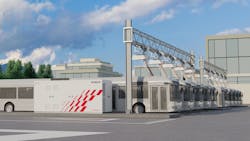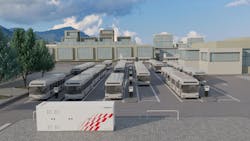Fleets must focus on digital tech, maintenance during transition to EVs
Commercial fleet operators are increasingly considering electric vehicles to help them achieve their cost and efficiency goals, and to support greenhouse gas emission reduction targets. Recent analysis on total cost of EV truck ownership, which includes capital, fuel, and maintenance costs, shows light-duty commercial EVs compare very favorably with their diesel counterparts. This is promising news for fleet operators looking to reduce their carbon footprint while maintaining efficiency and keeping costs in check—paramount priorities for their business.
Additionally, EVs need to be integrated into existing IT systems such as telematics and vehicle maintenance, dispatch, routing, and other systems used to manage fleets. These systems must be prepared to support both internal combustion engine vehicles and EVs in parallel during what are likely to be extended transitions to all-EV operations. This is where digital technologies can play a critical role in transitioning fleets to electric vehicles.
Digital solutions can drive efficiencies and cost savings for fleet operators. Data integration and analytics capabilities can be used to drive maintenance processes, for instance, that can help keep fleet vehicles on the road and reduce down-time for repairs. Similar capabilities can also be applied to the challenge of optimizing energy usage to ensure that vehicles can be charged at the lowest cost, based on time-of-day price variations and other factors.
Assessing the demands of commercial EVs
The average light-duty passenger vehicle requires 30 kilowatt-hours (kWh) to travel 100 miles, or the rate of consumption is 3.3 miles/kWh. For perspective, this 30 kWhs is roughly the same amount of electricity an average American home uses each day to run appliances, computers, lights, and heating and air conditioning. Energy usage by commercial EVs will be greater with fewer miles traveled per kWh. In addition, EVs, especially commercial EVs, consume energy in a compressed time frame. They run on batteries which demand a relatively large amount of power in a relatively short period of time when charging.
To meet the charging needs for commercial EVs, operators need to account for the fact that charging time will vary based on vehicle type, energy requirements, and dwell time. For example, a delivery van traveling 75 miles per day that is parked for nine hours each night could be charged sufficiently using a level-2 charger rated at only 7.2 kW. At 1.5 miles/kWH, the van would be able to travel nearly 100 miles on that nine-hour charge. If the van requires additional range, a larger battery and faster charger would be needed. Another option is to charge the EV when away from its home base. DC fast charging away from the depot would likely be required, adding additional dwell time to the route, which brings with it additional cost.
Level-3 chargers can reduce charging time dramatically, topping off a depleted battery in as little as 30 minutes, but that capability comes with a cost, both in terms of charging equipment and associated on-site electrical infrastructure. Despite the substantial up-front cost, the time savings make these systems particularly attractive for commercial environments where a large number of vehicles need to be charged, such as delivery and field services fleets. Increasingly, charging systems are becoming available that are optimized for vehicle fleets, and tailored to depot or terminal environments.
The reality is that fleet operators will need to perform a complex balancing act between charging requirements (kWh required), available dwell time, energy pricing (peak vs. off-peak), and other factors. They may also uncover some unexpected opportunities—some commercial or public EV fleets, because of their substantial battery storage capacity, may have the opportunity to provide a service as an energy storage provider during long idle periods, like evenings and weekends. These idle periods could provide opportunities to provide grid services or support backup power needs for themselves or other businesses. For instance, operators of fleet vehicles that have these longer idle periods, such as school buses that sit unused during the summer and holiday periods, can explore vehicle-to-grid (V-2-G) schemes to provide supplemental income by utilizing their unused storage capacity of the batteries in their EV school buses.
Challenges
Managing and operating a large fleet of on-road assets and associated supporting infrastructure presents a huge challenge that organizations including construction, logistics, delivery, and manufacturing companies need to navigate. Market competition, as well as factors such as rising fuel prices and the complex emission-based regulation, are forcing fleet operators to focus on driving efficiencies across their business operations.
One place that fleet operators can look to for savings is maintenance, which can account for approximately 15 to 20% of total fleet costs. Fleet managers typically rely on periodic maintenance schedules to keep their vehicles in service but have limited visibility into the actual health and performance of their assets. This can result in inefficiencies—for instance, some vehicles would be scheduled for maintenance even if they don’t need it while others requiring maintenance could break down in the field and disrupt service.
While transitioning to EVs can reduce maintenance requirements overall, it also offers ancillary benefits. For instance, commercial EV fleets will require accurate analysis of vehicle energy consumption and a plan to ensure maximum vehicle availability and utilization of EV charging infrastructure. These processes depend on digital solutions that can monitor vehicle battery state of charge, battery life data, route data, traffic simulations, and depot energy control to ensure that power usage and energy storage is optimized.
These same kinds of tools can be applied to development of more sophisticated maintenance scheduling processes. Tools such as Asset Performance Management (APM) platforms, for instance, can enable fleet operators to assess the relative health of vehicles, systems, or components, which in turn can enable them to schedule maintenance when it is truly needed and avoid unnecessary measures.
Digital technology for fleet maintenance
In order to manage their increasingly complex and sophisticated transport assets, fleet owners need a solution that encapsulates total maintenance optimization and automation across a fleet’s life cycle. With modern big data technologies, fleet owners can capture, store, and process all types of data. By capturing and analyzing maintenance-related data generated from across their fleets, operators can more effectively track and identify likely points of vehicle failure and address them proactively, a process known as predictive maintenance.
They can also take advantage of technologies like augmented reality (AR) to conduct efficient AR-guided inspections and repairs, indicate risk scores, and overall provide greater visibility into fleet performance and health. Together, these approaches can reduce operational maintenance costs and downtime, deliver better quality management and safety, and extend the maximum useful life of fleet assets at the lowest possible cost. Similarly, this same data and analysis can enable fleet operators to prioritize asset renewal and replacement based on real-time understanding of asset conditions and performance.
Conclusion
Fleet operators have the opportunity to drive efficiencies and cost savings by transitioning to EV operations. This transition depends on the implementation of digital fleet management solutions, which many fleet operators have already begun to adopt. These systems can be tightly integrated with EV charging solutions and data analysis platforms to provide enhanced visibility into fleet performance, which can be used to optimize maintenance, operations, safety, and fuel costs, ultimately helping fleet operators meet ambitious greenhouse gas emission goals and mandates.
Anthony Allard is Executive Vice President, Managing Director, United States and Head of Hitachi Energy’s business in North America. Allard was most recently Chief Operating Officer of BECIS, a leading energy as a service solution provider in Singapore. Having spent most of his career in the power sector at GE and Alstom in the US, he held several executive-level positions, including General Manager and Board Member for GE Prolec Transformers in the US. He was also General Manager for the GE-XD High Voltage Products partnership and spent 10 years working for Alstom Grid in both North America and the Americas in Strategy and Operations management roles.
About the Author

Anthony Allard
EVP, Managing Director, United States | Head of Hitachi Energy North America
Anthony Allard is Executive Vice President, Managing Director, United States and Head of Hitachi Energy’s business in North America. Allard was most recently Chief Operating Officer of BECIS, a leading energy as a service solution provider in Singapore. Having spent most of his career in the power sector at GE and Alstom in the US, he held several executive-level positions, including General Manager and Board Member for GE Prolec Transformers in the US. He was also General Manager for the GE-XD High Voltage Products partnership and spent 10 years working for Alstom Grid in both North America and the Americas in Strategy and Operations management roles.

